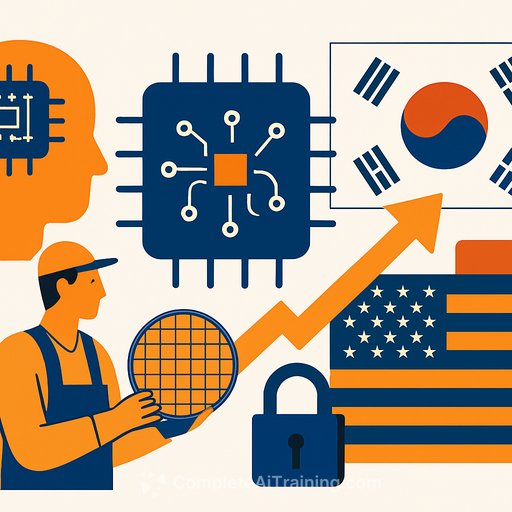AI demand sends South Korea's exports to a record - here's your sales playbook
South Korea's September exports jumped 12.7% year over year to a record $65.95B, beating a 7.2% forecast. Chips led the surge with a record $16.61B (+22%), as AI infrastructure spending keeps building. Autos climbed 17% on strong hybrid and EV orders.
Regional demand shifted. EU (+19.3%) and ASEAN (+17.8%) accelerated, China ticked back to growth (+0.5%), while the U.S. fell 1.4% on tariff pressure. Steel remained weak (-4.2%) under a 50% U.S. tariff.
Imports rose 8.2% to $56.40B. Trade surplus widened to $9.56B, the largest since September 2018. Equity markets opened higher; the won eased, supporting export price competitiveness. Note: calendar effects from the Chuseok holiday timing added a boost.
The numbers that matter
- Total exports: $65.95B (+12.7% y/y), fastest pace in 14 months
- Semiconductors: $16.61B (+22%), new monthly high
- Autos: +17% (hybrids and EVs leading)
- By market: EU +19.3%, ASEAN +17.8%, China +0.5%, U.S. -1.4%
- Steel: -4.2% (hit by 50% U.S. tariffs)
- Imports: $56.40B (+8.2%)
- Trade balance: +$9.56B, widest since Sep 2018
Where to point your pipeline
- Semis and AI infrastructure: Prioritize OEMs, foundries, memory suppliers, and data center builders. Buyers are active now and likely through the first half of next year.
- EV and hybrid supply chains: Pitch components, software, charging infra, and services bundled with financing or SLAs to remove friction.
- Regions to lean into: EU and ASEAN are hot; expand partners, local language collateral, and in-region demos.
- China: Early signs of stabilization. Test offers with quick feedback loops before scaling.
- U.S. accounts: Maintain relationships but protect margin. Build quotes with tariff-adjustment clauses and shorter validity.
Pricing, currency, and timing
- Currency: A softer won improves export pricing. Consider time-bound discounts in USD and add FX review checkpoints for multi-quarter deals.
- Calendar effects: September strength had holiday tailwinds. Don't over-index your Q4 forecast-anchor on semis/AI demand signals instead.
- Lead times: Confirm capacity with suppliers. Lock priority allocation for strategic accounts before year-end budgets close.
Tariff risk and talks: what to prepare
Talks to formalize a July framework that would cut U.S. tariffs on Korean imports (including autos) to 15% from 25%, tied to a $350B investment plan, have stalled on FX concerns. The government aims to push progress ahead of the late-October APEC window, but timing is unclear.
- Contracts: Add tariff passthrough language and re-price triggers.
- Bundling: Package software/services to offset hardware margin pressure.
- Scenario plans: Quote two price paths (status quo tariffs vs. eased tariffs) with clear effective dates.
Action plan for sales leaders
- Reweight territories: Shift SDR/AE focus to EU and ASEAN for Q4-Q1. Target enterprise buyers scaling AI and EV programs.
- Account list: Map top 50 AI data center builders, Tier-1/Tier-2 auto suppliers, and component distributors. Build multi-threaded relationships.
- Messaging: Lead with delivery assurance, energy efficiency, and TCO. Back it with case metrics and ROI calculators.
- Channel checks: Validate distributor inventory and RMA rates weekly. Use sell-through data to trigger promos, not instincts.
- Deal hygiene: Shorter quote validity, explicit lead times, and FX/tariff clauses on every proposal.
- Forecast discipline: Separate AI/semis (sustained) from calendar-boosted categories (volatile). Update commit weekly.
Signals to track
- Korea trade releases (official) for monthly export mix and tariff updates
- S&P Global PMI updates for factory activity momentum
Level up your AI-sales angle
If you're selling into AI or chip-linked accounts, sharpen your team's talk track and tooling fast. Use curated programs by role to speed up enablement.
Bottom line: ride the AI-driven demand in semis and EVs, prioritize EU/ASEAN, protect margin in the U.S. with tight terms, and keep your forecast honest. Momentum is real, but the tariff wildcard requires disciplined deal structure.
Your membership also unlocks:






